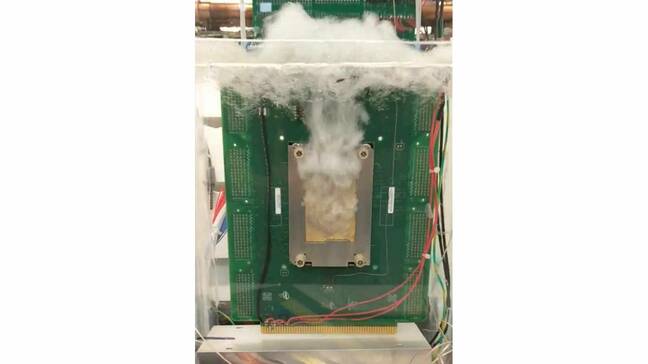Intel Details Coral-shaped Immersion Cooler That Bubbles Like Mentos In Coke
Intel on Tuesday detailed a novel immersion cooling heat sink design inspired by coral reefs, which it's working on thanks to a $1.7 million award from the US Department of Energy (DoE).
The x86 giant scored that cash under the DoE's COOLERCHIPS initiative, which aims to encourage tech that reduces the amount of power expended on datacenter cooling to less than five percent of the energy expended on IT itself. According to the agency, datacenters account for roughly two percent of total US electricity consumption, and of that roughly 40 percent is used up keeping the compute infrastructure from overheating.
Intel's contribution to this effort involves the development of a thermal management system for phase-change immersion cooling tanks that can cope with two kilowatt chips.
For those that aren't familiar, immersion cooling involves submerging whole systems – motherboard, memory, CPU, and all – in a bath of nonconductive fluids that capture heat from the system using a fraction of the power of air-cooled systems.
Intel is no stranger to liquid cooling. The chip shop launched a collaboration with Submer to explore single-phase immersion cooling back in 2021. It had even planned to build a $700 million research and development lab in Oregon dedicated to the tech, but that project was binned after Chipzilla ran into financial trouble.
- WTF is solid state active cooling? We've just seen it working on a mini PC
- Since when did my SSD need water cooling?
- When it comes to liquid and immersion cooling, Nvidia asks: Why not both?
- Money starts to flow as liquid cooling gets hot in datacenters
However, in this case, Intel is looking to develop heat sinks for use in two-phase immersion cooling tanks, which use specialized refrigerant liquids tuned to boil at the chip's operating temperature. The vapor is then allowed to condense and rain back down into the tank.
To achieve this goal, Intel aims to combine two core technologies, the first of which is specialized coatings that promote nucleation. If you remember back to science class, you might have learned how the tiny pits on Mentos candy's seemingly smooth surface acts as a nucleation site that allows dissolved gases to escape and cause an eruption of Diet Coke.

Intel demonstrates a specialized coating designed to help the immersion cooling refrigerants boil more vigorously – Click to enlarge
Intel's experimental cooling tech works on the same principle. But rather than making a mess, the idea is these coatings will help the refrigerant boil and thereby cool the chip more effectively.
The second core tech Intel is investigating concerns heat sink shapes.
"Today, fabricators apply these coatings on a flat surface, but research shows a coral-like heat sink design with internal groove-like features has the highest potential for external heat transfer coefficients with two-phase immersion cooling," Chipzilla explained in a press release.
Using its COOLERCHIPS cash, Intel plans to employ 3D printing to prototype heat sinks and vapor chambers based on these technologies, with the goal of improving the effectiveness of phase-change immersion cooling from 0.025°C/watt to 0.01°C/watt.
As we've previously reported, interest in liquid and immersion cooling has picked up in recent years as chips have grown more power hungry and systems have become more compute dense. So dense that GPU nodes can consume upwards of 10kW of power under load.
The DoE has a vested interest in addressing this challenge. In addition to reducing the load on the power grid, the DoE operates some of the largest, hottest, and most power hungry supercomputers in the world. As systems need more power, and make more heat, new technologies to manage both are clearly needed.
However, Intel is only one of several tackling the issue of thermal management. As we reported in May, Nvidia received $5 million in funding under the COOLERCHIPS program to combine direct to chip liquid cooling with immersion cooling in a standard rack. HP also received funding under the program, as did Raytheon and several universities. ®
From Chip War To Cloud War: The Next Frontier In Global Tech Competition
The global chip war, characterized by intense competition among nations and corporations for supremacy in semiconductor ... Read more
The High Stakes Of Tech Regulation: Security Risks And Market Dynamics
The influence of tech giants in the global economy continues to grow, raising crucial questions about how to balance sec... Read more
The Tyranny Of Instagram Interiors: Why It's Time To Break Free From Algorithm-Driven Aesthetics
Instagram has become a dominant force in shaping interior design trends, offering a seemingly endless stream of inspirat... Read more
The Data Crunch In AI: Strategies For Sustainability
Exploring solutions to the imminent exhaustion of internet data for AI training.As the artificial intelligence (AI) indu... Read more
Google Abandons Four-Year Effort To Remove Cookies From Chrome Browser
After four years of dedicated effort, Google has decided to abandon its plan to remove third-party cookies from its Chro... Read more
LinkedIn Embraces AI And Gamification To Drive User Engagement And Revenue
In an effort to tackle slowing revenue growth and enhance user engagement, LinkedIn is turning to artificial intelligenc... Read more

